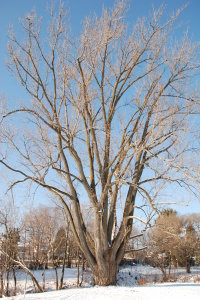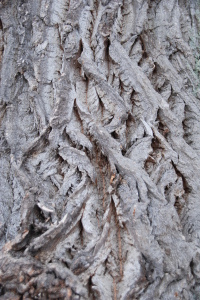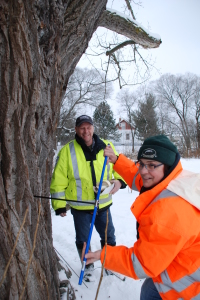Cottonwood – Biggest Tree in Northern Ontario – North Bay
Big Tree – A Mystery – Spiritual and Energy Within
by Back Roads Bill
 Trees have an interesting role in the world of spirituality. We may instantly think about the practice of decorating a Christmas tree. Trees like all living things have an energy frequency or vibration and an aura.
Trees have an interesting role in the world of spirituality. We may instantly think about the practice of decorating a Christmas tree. Trees like all living things have an energy frequency or vibration and an aura.
In many cultures both ancient and modern, our largest plants, are thought to possess energy and are considered sacred. Within these cultures it is thought trees influence spiritual lives. For those that believe, coming into contact with a tree you pick up these vibrations whether you are consciously aware of it or not. You begin to resonate with the tree’s energy and you become more centered and grounded. This can help explain the comfort many people feel when they sit down under a tree. When was the last time you climbed a tree – that was fun.
Most likely one of largest trees in Northern Ontario, is located within the City of North Bay. It is massive at the base and it is ten trees in one; it is unusual.
The Mystery Begins
Because of the interest and measurements undertaken by Guylaine Thauvette, Management Forester, Ontario Ministry of Natural Resources and Forestry, North Bay District we now know this tree has a diameter of 86” or 2.2 metres, circumference of 270” or 7 metres and is about 30 meters tall, almost 100’. To put this into perspective the large and stately white pine trees near Marten River are between 300-400 years of age and are similar in diameter. Cottonwoods (poplars) grow faster and the large size of this tree is because it is growing beside Chippewa Creek. Apparently a few years back, a number of large cottonwoods were cut down on First Ave. near the Legion.
At the beginning of this mystery she said, “Now for the exact species, I’m not sure. It’s not a local native species – a trembling aspen,  large tooth aspen or balsam poplar. The leaf and bud characteristics do not match any of the descriptions in the ‘Trees of Canada’ by John Laird Farrar (Canadian Forest Service). Based on my internet search and Trees of Canada, it looks like it may be a hybrid between a cottonwood (either black or eastern) and balsam poplar. This makes this tree even more of a mystery because it is planted or from a seed from another area.” It was also determined the tree is in the North Bay Mattawa Conservation Authority’s (CA) 1983/84 tree inventory. It’s identified as an eastern cottonwood. At that time the diameter was 158 cm.
large tooth aspen or balsam poplar. The leaf and bud characteristics do not match any of the descriptions in the ‘Trees of Canada’ by John Laird Farrar (Canadian Forest Service). Based on my internet search and Trees of Canada, it looks like it may be a hybrid between a cottonwood (either black or eastern) and balsam poplar. This makes this tree even more of a mystery because it is planted or from a seed from another area.” It was also determined the tree is in the North Bay Mattawa Conservation Authority’s (CA) 1983/84 tree inventory. It’s identified as an eastern cottonwood. At that time the diameter was 158 cm.
The ‘Trees of Canada’ is the book you want for Christmas, it states: “the natural populations of poplar are difficult to classify into species.” The eastern cottonwood (Populus deltoids) is found “…the Montreal area and in southern Ontario near lakes Erie and Ontario and is not a common tree…large trees up to 30 m high, 100 cm in diameter and 50 years old.” It is identified as the “fastest growing native tree” and is found “on the banks of streams.”
It has grown during the past two decades. At a second visit it was discovered there was a tag on the west side of the tree, #135 (thanks to city employee, James Stewart, who just happened to be driving by, coincidence or synchronicity; that was a past article; he provided some new information). Apparently in the 1980’s the city’s parks and recreation department started an inventory of “assets” and the Duke St. tree was identified, most likely as an anomaly.
Solving the Mystery
Guylaine then located a 80 cm increment borer and soon met with Troy Storms, Supervisor, Field Operations for the CA.
“A 75 cm core easily came out of the increment borer. Guylaine said, “That’s impressive because it means most of that tree trunk is sound. It likely survived and avoided destruction because it is within a City of North Bay property that looks like a road allowance along the street.” The first colonization road into North Bay (Old Callander Road) is in close proximity (Seymour St.) and there were original farmsteads here.
Unbeknownst to the writer, Guylaine’s family portrait had been previously taken at this majestic tree. “About the family picture – I noticed this tree about ten years ago, likely when I parked along Duke street to go to the paint store that used to be on the corner. We were planning to have our family picture professionally taken. That tree was the perfect setting for the photograph. My husband and I work in forestry and our children grew up looking at all kinds of things in the forest. “
Troy explained the cottonwood needs pruning from time-to-time not only for its health, but also to ensure it isn’t a hazard for people and property along Chippewa Creek and the EcoPath. The CA arranges for a certified arborist who has the skills and the specialized equipment, including boom trucks, to prune dead or damaged branches often high in the crown of the tree. It is a big tree.
“ A great way for people to experience this tree and admire both its beauty and its majesty is to stand back and take it all in, from the trunk right up to canopy. It’s amazing, especially when you feel the bark and imagine it’s actually a part of our community’s history. ‘He advises, “We ask that people do not climb or remove any part of the tree or it surroundings. On windy days it’s wise to observe it from back at the road to watch the branches and leaves dance in the wind. “
A great way for people to experience this tree and admire both its beauty and its majesty is to stand back and take it all in, from the trunk right up to canopy. It’s amazing, especially when you feel the bark and imagine it’s actually a part of our community’s history. ‘He advises, “We ask that people do not climb or remove any part of the tree or it surroundings. On windy days it’s wise to observe it from back at the road to watch the branches and leaves dance in the wind. “
What does he think about its majestic nature and stateliness? “People often develop a fondness for large, long-standing trees and, like this one, see it as an important part of the community. Its deep thick protective outer bark and the size of its trunk tells us this tree is a survivor withstanding wind, climate change, floods, beavers and human impacts. It’s both calming and awe-inspiring to find it within this urban setting.”
He recommends going to www.chippewaecopath.ca , an initiative including the CA, the city, the North Bay Heritage Gardeners and list of other partners. It is a contemporary and ongoing mitigation project because of the years erosion caused by flooding, development and pollution.
And Finally
The mammoth cottonwood is located on Duke St. East, just west of Fisher St, behind the Arugala Restaurant. You can see where the bank beavers, just downstream at the bend of Chippewa Creek, have had a futile go (“chew”) at this giant.
Professor Jeff Dech is a forest researcher, at Nipissing University. “This is an unofficial approximate age given that we have not cross dated the sample, and that the sample did not reach the centre of the tree (missing 41.2 cm of the core) I dated the inside ring on the sample to 1937, making a total of 77 rings on the core. That may seem much lower than expected for a tree that size; however, the individual rings on the sample are really large,” he said. This is often the case for trees growing in the open, with an ample supply of water. It may be that this tree was open grown for much of its lifetime, and would have had access to moisture along the banks of the creek. Another characteristic of trees growing in mesic environments like this is something dendrochronologists call complacency (there is very little variation in ring width, because in any given year the tree has access to all the resources it requires).” Further to this Guylaine was able to measure average radius inside bark and by using a ratio the tree is approximately 117 years. ”By any measurement, this is a very old poplar/cottonwood.”
Biblical scriptures mention trees as in the “tree of life” and the “tree of knowledge of good and evil” within Genesis. Buddhism has connections to the Bodhi tree where Buddha was known to have reached enlightenment as he sat and meditated. Druids and pagans were known to practice worship among sacred groves of trees.
If you want to know more about the spirit within trees go to www.spiritoftrees.org it is a resource for therapists, educators, environmentalists, storytellers and tree lovers. No matter what this is a special tree, step back and look at the crown, stand beside it to get a sense of size and feel the furrowed bark. At least go and have a look it is waiting for you to take a “selfie.” Maybe the hippies had the right idea when they advised people to go “hug a tree.” (“Ah go on, just do it!) Anthropomorphism, maybe this tree needs a name?
